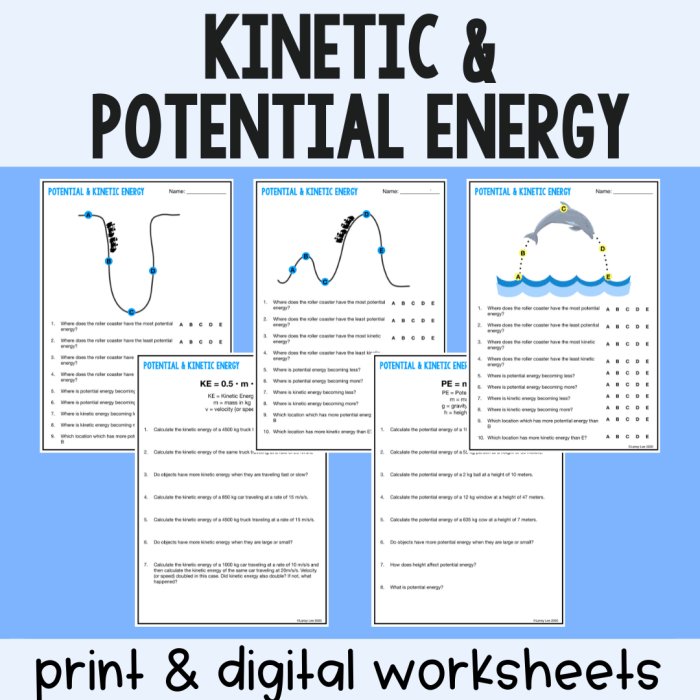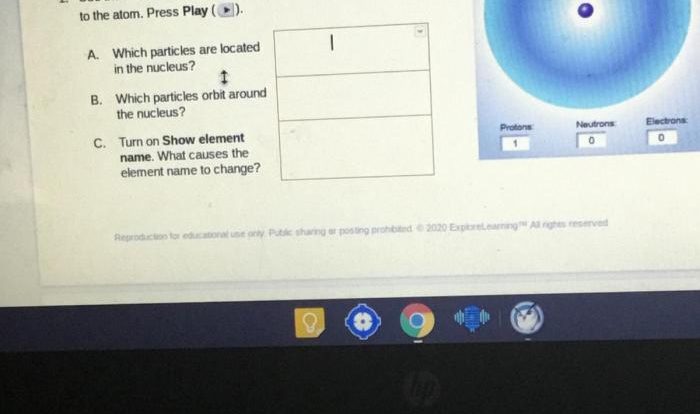Unveiling the Potential and Kinetic Energy Webquest Answer Key, this guide embarks on an enlightening journey into the realm of energy, unraveling its forms and applications with precision and clarity. Embarking with the fundamental concepts of potential and kinetic energy, we delve into their interplay and explore their practical implications in various fields, leaving no stone unturned in our quest for knowledge.
Proceeding further, we meticulously examine the units of measurement and formulas employed in quantifying potential and kinetic energy. Interactive activities and simulations are ingeniously designed to solidify comprehension, fostering an immersive learning experience. A comprehensive glossary of terms serves as an invaluable resource, providing lucid definitions and explanations at your fingertips.
Understanding Potential and Kinetic Energy
Potential and kinetic energy are two fundamental forms of energy that play a crucial role in our physical world. Potential energy is the energy stored within an object due to its position or configuration, while kinetic energy is the energy an object possesses due to its motion.
Potential energy can be thought of as stored energy, like a coiled spring or a raised object. Kinetic energy, on the other hand, is energy in action, like a rolling ball or a flowing river.
Examples of Potential and Kinetic Energy
- A ball held above the ground has gravitational potential energy.
- A stretched rubber band has elastic potential energy.
- A moving car has kinetic energy.
- A flowing stream of water has kinetic energy.
Relationship between Potential and Kinetic Energy
Potential and kinetic energy are interconvertible. As an object moves, its potential energy decreases while its kinetic energy increases. Conversely, as an object slows down, its kinetic energy decreases while its potential energy increases.
Measuring Potential and Kinetic Energy

Units of Measurement
Potential energy (PE) is measured in joules (J), while kinetic energy (KE) is also measured in joules (J).
Formulas for Calculating Potential and Kinetic Energy
- Gravitational potential energy:PE = mgh, where m is the mass of the object, g is the acceleration due to gravity, and h is the height of the object above a reference point.
- Elastic potential energy:PE = 1/2kx 2, where k is the spring constant and x is the displacement of the spring from its equilibrium position.
- Kinetic energy:KE = 1/2mv 2, where m is the mass of the object and v is its velocity.
Practice Problems
1. A 10 kg ball is held 2 meters above the ground. Calculate its gravitational potential energy.
2. A spring with a spring constant of 100 N/m is stretched 0.5 meters. Calculate its elastic potential energy.
3. A car with a mass of 1500 kg is moving at a speed of 20 m/s. Calculate its kinetic energy.
Applications of Potential and Kinetic Energy
Physics, Potential and kinetic energy webquest answer key
Potential and kinetic energy are fundamental concepts in physics. They are used to explain a wide range of phenomena, including the motion of planets, the flow of fluids, and the behavior of waves.
Engineering
Potential and kinetic energy are essential considerations in engineering design. Engineers use these concepts to design machines, structures, and devices that efficiently utilize energy.
Sports
Potential and kinetic energy play a significant role in sports. Athletes use their understanding of these concepts to improve their performance and optimize their techniques.
Interactive Activities and Simulations

Activity: Roller Coaster Energy
This activity allows students to explore the conversion of potential and kinetic energy using a roller coaster simulation. Students can adjust the height of the roller coaster and observe how its potential and kinetic energy change throughout the ride.
Simulation: Energy Skate Park
This simulation allows students to experiment with different types of energy transformations in a skate park setting. Students can create their own obstacles and ramps and observe how the skater’s potential and kinetic energy change as they navigate the park.
Online Resources
- Khan Academy: Gravitational Potential Energy and Kinetic Energy
- PhET Interactive Simulations: Energy Skate Park
Glossary of Terms: Potential And Kinetic Energy Webquest Answer Key
- Kinetic energy:The energy an object possesses due to its motion.
- Potential energy:The energy stored within an object due to its position or configuration.
- Gravitational potential energy:The potential energy an object possesses due to its position in a gravitational field.
- Elastic potential energy:The potential energy stored in a deformed elastic object, such as a spring.
FAQs
What is the significance of potential and kinetic energy?
Potential and kinetic energy are fundamental concepts in physics, describing the energy stored within objects due to their position or motion, respectively. Understanding these forms of energy is crucial in comprehending a wide range of phenomena, from the motion of celestial bodies to the operation of machines.
How can I calculate the potential and kinetic energy of an object?
Potential energy is calculated using the formula PE = mgh, where ‘m’ represents the object’s mass, ‘g’ is the acceleration due to gravity, and ‘h’ is the object’s height. Kinetic energy, on the other hand, is calculated using the formula KE = 1/2mv^2, where ‘m’ is the object’s mass and ‘v’ is its velocity.
What are some practical applications of potential and kinetic energy?
Potential and kinetic energy find applications in numerous fields, including engineering, sports, and energy production. For instance, the potential energy stored in a stretched rubber band is utilized in catapults, while the kinetic energy of moving water is harnessed in hydroelectric power plants.

